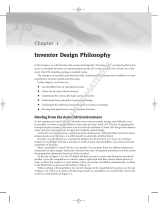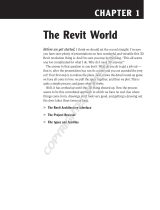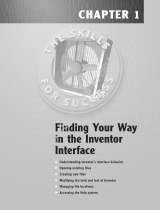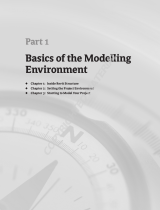
Autodesk
®
Inventor
TM
Routed Systems Suite

Autodesk
®
Inventor
™
software products are the best
choice for AutoCAD
®
software users who want to add
the power of D without compromising investments in
D design data and AutoCAD technical expertise.
Add the power of D with the company that brought you D.
As the creators of AutoCAD software, Autodesk
understands your design process and created
Inventor to make the process of adding D as easy
as possible. No company is more focused than
Autodesk on helping designers create and bring
better products to market faster at less cost.
Inventor gives designers the freedom to integrate
existing D designs into their D design environment,
making it easy to reuse and share both AutoCAD
®
DWG™ files and D design data with other Autodesk
manufacturing applications and their users. With
innovative approaches to accelerate and simplify
the concept-to-manufacturing process, it’s no
wonder Inventor has outsold all competitors for
the sixth consecutive year.
The Right Tools for Your Design Process
The Inventor product line provides a comprehensive
and integrated set of design tools for D design
and documentation, creating routed systems,
and validating designs. Inventor not only includes
data management software and AutoCAD
®
Mechanical for D drawing and detailing, but
also delivers enhanced D productivity while
preserving your company’s D engineering
designs through true DWG interoperability. It
provides access to intelligent engineering
content and oers the fastest way to generate
production-ready drawings to help designers
quickly go from concept to production.
Specialized Tools for Your Design Needs
Save time and reduce prototyping costs with
specialized tools that help engineers to create
and validate routed systems, including tube, pipe,
or wire harness designs. Autodesk
®
Inventor™
Professional software provides the tools to create
complete products, including complex routed
system designs, while automatically creating
accurate bills of materials (BOMs) and complete
manufacturing documentation.
Validate designs before they are built. With
Autodesk Inventor Professional, engineers
can simulate the dynamic behavior of a design
throughout its full operating cycle and accurately
predict operating loads and accelerations. In
addition, the integrated Finite Element Analysis
(FEA) tool helps engineers analyze designs and
avoid stress-related field failures.
With dierent product configurations that oer
specific levels of functionality, Inventor is the best
choice for AutoCAD users in manufacturing.
Contents
Digital Prototypes ........................................ 3
Tube and Pipe Design ..................................5
Cable and Harness Design .........................8
AutoCAD Integration ................................ 12
Part Design ..................................................14
Assembly Design ........................................ 18
Design and Manufacturing
Documentation ......................................... 22
Collaboration and Communication ...... 24
Customization and Automation .............27
Learning Resources .................................. 29
Learn More or Purchase .......................... 30
2

3
Make sure designs work before spending money
on prototypes or manufacturing tooling.
Digital Prototypes
With Inventor, D digital
prototypes are complete
and accurate models that
enable users to check
design and engineering
decisions as they work,
minimize the need for
physical prototypes, and
avoid costly changes
when the design is sent to
manufacturing.
3D Digital Prototyping
Test and simulate designs early in the design
cycle to deliver more innovative, higher-quality
products while reducing manufacturing costs
and decreasing time to market.
• Work with parts and assemblies to lay out and
resolve design function before committing to a
prototype or finished part.
• Readily view sketches, parts, and subassemblies
during and after creation in the context of the
design, helping you make the right design choices
throughout the process.
• Use Positional Representations to evaluate your
assembly design in dierent positional states.
Rendering courtesy of
Prensa Jundiaí, Brazil.

4 4
Assembly STL Output
Quickly create stereolithography (STL) files for
rapid prototyping of Inventor assemblies. Save as
STL file format directly from the Inventor
assembly environment.
Physical Properties
Design better products by using real-world
properties during virtual prototyping. Parts and
assemblies created in Inventor carry physical
property information that helps designers make
important design decisions. Tracked properties
include center of gravity, material type, density,
color, and texture.
Interference Analysis and Contact Detection
Reduce costly errors and improve manufacturability
by testing assembly function within Inventor.
• Test part interference with automated tools,
allowing the parts to be measured for fit.
• Drag a component to collide with another
component, and validate that the reaction
is correct.
• Isolate selected components in a contact set to
determine whether the components behave in the
expected mechanical motion.
AutoLimits
Reduce errors and engineering changes through
automatic monitoring of key design rules. AutoLimits
provide color-coded warnings when a monitored
parameter exceeds the prescribed design limit.
Use AutoLimits to monitor length, distance, angle,
diameter, loop length, area, volume, and mass.
Digital Prototypes

5
Pipe Routing
Create and modify pipe routes quickly and easily
by selecting a start point, an end point, and any
number of intermediate points to define the route.
Complete associativity means that pipe routes
automatically update when the D assembly
changes. Constrained routing gives users precise
control over the location of piping runs using D
Sketch tools. Rules-based routing enables users
to automatically adhere to design rules, such
as minimum or maximum length criteria, while
creating and modifying pipes.
Flexible Hose
Make sure flexible hose and fittings fit properly
using a D digital prototype that drives accurate
manufacturing documentation. The system inserts
appropriate hose fittings from the Content Center
and checks for minimum bend radius based on
the selected hose style. Hose lengths are updated
automatically for use in length roll-up commands.
Custom Bends in Pipe Runs
In real-world piping designs, users may need
to bend a pipe rather than insert an elbow. The
Custom Bend command provides flexibility and
control even for nonstandard designs. Create
bends of custom radius and angle with the familiar
methods used for rigid tubing.
Inventor enables users to reduce the time required
to design tubing, piping, and flexible hose.
Tube and Pipe Design
The rules-based routing
tools in Inventor select
the appropriate fittings and
help ensure that
pipe runs comply with
design rules for minimum
and maximum length,
round-o increments, and
bend radius.
Flanged Pipe Style
Make sure the correct fittings and gaskets are used
when designing pipe runs with flanged fittings.
Inventor automatically populates the pipe run
with flanged components, replacing couplers with
flanged components and the corresponding gaskets.

Rigid Tube Routing
Quickly create rigid tubes with superior control
over the shape, bend angles, and radii. Create
rigid tubes with an arbitrary number of bends and
variable custom bend angles and radii. The radius
and rotation handles oer greater control over the
shape of a rigid tube.
Fittings Library
Improve quality, easily organize parts, and eliminate
tedious searching with automatic placement of
the correct part from an extensive library of piping
components. The library includes commonly used,
industry-standard (ANSI, DIN, ISO, and JIS) fittings,
tubing, piping, and hose. Add or modify properties,
including part numbers to existing parts and control
file names used to instance fittings, pipes, tubes,
and other content.
Butt Welded Pipe Style
Create accurate pipe lengths when defining welded
pipe runs. Inventor automatically populates the
pipe run with welded components and adjusts the
segment lengths to allow for the correct weld gaps.
Creating Runs
Automatically populate piping routes with real
parts that adhere to manufacturing standards. The
Populate Route tool turns tube, pipe, and hose
routes into physical pipe runs, automatically placing
fittings, pipe segments, rigid tubes, and hoses
as needed. Standard Inventor parts are created
during this process to make it easy to perform mass
property calculations and interference checks. In
addition, couplings are automatically placed when
pipes reach their maximum length, and users can
specify length cuto increments.
Tube and Pipe Design
6

ISOGEN PCF Output
Use the piping component file (PCF) output to
reduce errors by automatically creating isometric
pipe drawings with third-party applications. Create
PCF files to use as an interface to the industry-
standard Alias ISOGEN software. Based on the
PCF input file, ISOGEN creates a DXF™ or DWG
file containing the isometric drawings.
Tube and Pipe Styles
Increase the quality and manufacturability of
designs by helping to ensure that tube and pipe
runs automatically adhere to preset design
standards. Create tube and pipe styles to
support the use of threaded, welded, and flanged
connections. Styles define the fittings to be
used for both automatic and manual routing, and
enforce design rules, including minimum segment
lengths and minimum bend radii, as wells as the
maximum length between couplings.
Assembly Documentation
Quickly and easily include accurate details about
tubing, piping, and hose locations in assemblies.
Since all the tube and pipe geometry is native to
Inventor, users can easily create assembly documen-
tation using standard Drawing Manager functions.
Tubing Bend Tables
Save time and reduce errors by automatically
generating bend tables based on D data. Create
nonassociative ASCII bend tables in standard XYZ
or YBC formats to provide details to manufacturing.
Branch Fittings
Extend piping models to include threaded and
welded branch fittings. Select a branch fitting from
the Content Center and place it onto a pipe run
using interactive controls to define the linear and
circumferential position. Branch fittings added
in this way automatically generate the correct
attachment hole in the existing pipe.
Route and Run Copy
Increase productivity by quickly and easily reusing
complete pipe routings from a previous design.
Tube and Pipe Design

Use Inventor to design cable and harness runs—
including ribbon cables—and save time and resources.
Cable and Harness Design
Intelligent Wire Creation
Simplify the design of electrical wiring, and reduce
manufacturing errors by maintaining consistency
between the electrical schematic and D wire
harness design. With Inventor, wire list and
connector information is used to drive harness
design with built-in cross-checking of electrical and
mechanical data, so all wires and connectors in the
wire list are represented in the D cable design.
Inventor streamlines cable
and harness design by
using wire list information
imported from schematic
design packages, including
AutoCAD
®
Electrical
software.
Wire List Import
Maintain electrical design intent and reduce errors
when importing wire lists into the assembly. Quickly
import large wire lists from AutoCAD Electrical
or third-party schematic design applications with
detection and correction of missing connectors,
pins, and wire definitions.
Harness Path Definition
Optimize the design of cable and harness
assemblies to help ensure proper spacing
for manufacturing and to reduce errors in
manufacturing caused by incomplete product
definition. Define harness and cable paths using
a point-and-click methodology that creates D
virtual conduits (segments) in the model. Create
associative relationships that ensure that the
harness updates when design components change.
Add points or move existing points to refine the
overall shape of the harness.

Wire Routing
Use automated and manual wire routing options
to quickly route thousands of wires while
maintaining complete control over the paths
of critical conductors. Wires are inserted into
segments using three routing functions:
• Manual routing requires explicit selection of
a wire’s path.
• Interactive routing requires selecting the start
and end points of the routed path to let an
algorithm choose the shortest path.
• Automatic routing finds the shortest possible
path based on all available paths.
Ribbon Cables
Reduce errors in the design of electronic equipment
by incorporating ribbon cables in your D digital
prototype. Add ribbon cables between connectors
with full control over the locations of twists and folds.
Wire Harness Copy
Reuse harness design runs—and save valuable
design time. Use a past design as a starting point by
copying and reusing existing harness assemblies.
XML Output
The XML Output function provides a complete
description of the harness assembly in an easily
readable, language-independent XML file. Transfer
wire connectivity information to AutoCAD
Electrical to streamline the creation of schematics
and wiring diagrams.
Report Generation
Streamline and automate the creation of
reports with centralized data storage. Define
report formats and run reports such as wire
lists, termination charts, cut tables, and others
needed to design and manufacture harnesses.
Cable and Harness Design

Virtual Parts
Generate accurate bill of materials data for better
purchasing and cost forecasting. Select harness
elements, such as clips, terminals, looms, and
labels, and insert them into the cable design as
nongraphical parts that are fully integrated with
the Inventor BOM.
Connector Authoring
Set up company-specific connector libraries to
encourage the use of preferred connectors in the
design of electrical products. Inventor includes
an extensive library of connectors to simplify
selection and placement. The Content Center
provides an easy-to-use editor to add user-defined
connectors, as well as add or modify properties such
as part numbers and default file names used
when instancing connectors.
Bundle Diameter Calculation
Use D visual inspection and interference detection
tools to accurately determine whether wire bundles
will fit correctly in the assembly. The software
automatically calculates bundle diameters when
wires are added or removed from the segments,
even accounting for the actual wire diameters and
air gaps between wires.
Multiconductor Cables
Improve quality and prevent errors by tracking
individual cable conductors and their connections
and routing paths. Minimize waste by creating
a more complete BOM that includes accurate
cable length and quantity data. Create intelligent
representations of multiconductor cables, track
which conductors within a cable are in use or
available, and use route and unroute commands so
all wires within a cable are routed together. Users
can also
• Use existing wire list import functionality to
import cables automatically
• Create bills of materials that accurately display
cable data rather than individual wires
• Create configurable reports on cables
10
Cable and Harness Design

Wire Length Calculation
Automatically calculate highly accurate wire
lengths that update as the design changes.
Length compensation factors enable fine control
over wire and cable lengths, reducing scrap and
manufacturing delays caused by wires that are too
short or too long. What’s more, the Embedded
Length feature provides the ability to account for
the amount of wire that is used beyond the point
where the wire enters a connector or splice. Global
Slack adds extra length to all wires and cables based
on a percentage of their length. And the Round Up
feature produces practical, manufacturable wire
lengths by rounding the wire and cable length up to
the nearest specified unit.
Bend Radius Checking
Improve cable quality and manufacturability, and
prevent costly recalls by adhering to minimum bend
radii. Identify points of failure due to tight turns and
test manufacturability of bends along large bundles.
Nailboard Diagrams
Minimize drawing iterations by quickly creating
accurate D harness documentation and ribbon
cable documentation that automatically update as
the D design changes—reducing errors caused by
manual drawing methods. Place connector images
in a single step using predefined orientation, scale,
and oset settings. Manipulate and annotate for
manufacturing, adding pin, wire, and connector
properties; location of fold lines for ribbon cables;
and other data needed to build the harness or cable.
Assembly Documentation
Quickly and easily create manufacturing
documentation before building the first article.
Since cable and harness geometry is native to
Inventor, users can create assembly documentation
showing accurate details of cable and harness
placement.
Cable and Harness Design

Only Inventor provides DWG TrueConnect, delivering
industry-leading integration of D and D design through
direct read and write of the DWG format with full
associativity to the D design data without translators.
AutoCAD Integration
Autodesk Inventor
drawings saved as DWG
files provide view, plot,
and measure with
exceptional visual
fidelity for improved
sharing of manufacturing
information. With
DWG Read, users save
valuable time by opening
AutoCAD designs in
Inventor. Easily combine
views generated from
D part and assembly
designs with AutoCAD
data such as schematics
and plant layouts. Update
old D drawings by
inserting views of new
D designs to reduce the
cost of upgrading existing
equipment.
Ease of Use
Reduce the time and training required for AutoCAD
users to become proficient in D design workflows.
Simplify the transition from AutoCAD to Inventor
in a familiar design environment with recognizable
icons, AutoCAD-compatible shortcuts, cursor-based
prompts, and command redo. User profiles enable
users to configure Inventor to match the way they
work, with out-of-the-box profiles for AutoCAD and
Inventor experts. In addition, users can transfer
their settings between dierent computers by
exporting the profile to XML.
Inventor-AutoCAD Mechanical Interoperability
Accelerate time to market and reduce errors by
enabling associative D and D collaboration.
With this interoperability, AutoCAD Mechanical
software creates drawings of Inventor components
by enabling users to open native Inventor parts and
assemblies. When the design changes in Inventor,
the AutoCAD Mechanical drawing is automatically
updated.
Mechanical Desktop Import
Simplify the migration of Autodesk
®
Mechanical
Desktop
®
software designs to Inventor to easily
capture part, assembly, and drawing intelligence.
Reuse Mechanical Desktop models and drawings as
parts, assemblies, and drawings in native Inventor
format while maintaining their original design
constraints and drawing relationships. Migration
functionality supports automatic drawing view
creation, recognizing model-to-drawing associativity
for annotations, scenes, unit settings, and more.
12

DWG Open
Gain access to existing D design data without
installing or learning AutoCAD software. Open
AutoCAD drawings directly in the Inventor
application so you can view, plot, and measure
using familiar Inventor commands. Incorporate
existing D design data into D design workflows
using Copy and Paste.
Template Synchronization
Open a DWG file in Inventor and automatically
create layers and dimension and text styles based
on the AutoCAD styles in the DWG file, thus
reducing the time required to create drawings that
comply with your customers’ drawing standards.
AutoCAD Blocks from Inventor Views
Reduce the cost of using D for upgrade projects
originally designed in D. This feature generates
AutoCAD blocks from Inventor drawing views so
users can redesign subassemblies using Inventor
and then integrate the new drawing views directly
into the original drawings.
DWG Save
Integrate DWG technology into the D design
workflow to take advantage of existing skills; easily
combine part, assembly, and schematic drawings
data; and streamline communication with suppliers
and partners who rely on DWG technology. This
feature stores Inventor drawing views in the DWG
file to provide view, plot, and measure in AutoCAD
with complete visual fidelity, while preserving fully
associative drawing updates.
13
AutoCAD Integration

Sketching
Evaluate dierent design ideas before creating
detailed part and assembly models. By using the
Inventor sketch environment, you can quickly
capture design ideas as versatile D layouts. By
combining the power of constraints with easy-to-
use tools for modifying sketches, you can try
dierent design concepts and control color and line
style to help convey your design ideas.
With the power of functional design, Inventor
helps you focus on the functional requirements
of a design to drive the creation of D models and
create competitive product designs in less time.
Part Design
14
Fully associative models
help ensure that any
changes to the part
design are automatically
reflected in the assembly
and drawing files, so
that the complete design
and manufacturing
documentation is accurate
and current.

Feature Generator
Drag-and-drop shape libraries accelerate the
transition to D modeling by making it easy and
fast to create and edit parts. Use the feature
generator to create fully editable Inventor parts
by simply dragging shapes from a library of
standard geometry.
Associativity
Take advantage of automatic propagation of design
changes to reduce errors and accelerate time to
market. Associate parts and assemblies with design
relationships, so that a change made to a part is
reflected in the assembly design and all associated
drawing files. In addition, a change to the assembly
is reflected in the parts and drawing files. This
means that if users edit associated components,
such as parts and subassemblies, those changes
ripple throughout all parts, assemblies, presentations,
drawings, and related partner add-ins (such as
computer numeral controlled (CNC) tool paths or FEA).
15
Sheet Metal Punch Libraries
Users can define their own sheet metal punch
libraries to standardize punch usage and reduce
CNC tooling costs. Table-driven punches enable
users to define families of punches, typically
dierent sizes of the same punch shape with full
representation of manufacturing parameters,
including PunchID, punch depth, and sketches
for alternate punch representations.
Part Design

Advanced Shape Description
Create a wide range of complex geometries by
easily combining solids and surfaces. Inventor gives
users precise control of shape characteristics, such
as tangency and continuity. Advanced modeling
tools include Loft to a Point, N-Sided Patch, Sweep
Normal to Surface, Area Loft, Centerline Loft, G2
Continuous Fillets, Full Round Fillets, and Face-to-
Face Fillets.
Sheet Metal API
The Inventor API (application programming
interface) provides access to the flat pattern
and punch library data required to build highly
automated shop floor integration to CNC punch
machines so users can transfer design data
directly to manufacturing operations and get
products into production as quickly as possible.
Sheet Metal DXF Output
Reduce programming time by eliminating time
spent cleaning up DXF files for CNC machining.
DXF/DWG export for sheet metal provides control
of preprocessing and postprocessing options such
as DXF/DWG file version, layer mapping, user-
defined chord length for spline simplification, and
customization through external XML files.
Geometry Analysis
Create models with high-quality surface character-
istics, and check design data for manufacturability
to avoid costly changes during manufacturing setup.
Comprehensive analysis tools for checking geomet-
ric properties of a design are available in both the
part design and construction environments. Tools
include the following:
• Zebra analysis with density control and enhanced
display accuracy, providing visual confirmation of
surface continuity and tangency
• Gaussian surface analysis, providing feedback of
surface curvature
• Cross section analysis displaying wall thickness
with color-coded feedback of minimum and
maximum thickness violations
• Draft angle analysis displaying color-coded
draft angle based on a pull direction that can be
defined by an axis, plane, or planar face
• Check of minimum distance between two
components or faces in an assembly
Part Design

Sheet Metal
Accelerate the design of complex sheet metal parts
in D using specialized features to define sheet
metal structures, such as flanges, folds, miters,
seams, and corner reliefs. Edge chaining allows
creation of multiple flanges in a single step. Rich
unfold options and automatic mitering reduces the
time required to define the folded part model.
Sheet Metal Flat-Pattern Features
Generate optimized flat patterns to eliminate
unnecessary manufacturing costs. Unfold sheet
metal models to create flat patterns with associative
flat-pattern editing to support cleanup operations
such as modifying corner reliefs to match specific
capabilities available on the shop floor.
Import from Autodesk AliasStudio
Use concept design data from Autodesk
®
AliasStudio™ software to reduce the time required
to complete the D product design. Reuse curve
and surface data from AliasStudio using the DWG
import and export tools that are built into the two
products. Manipulate imported surfaces in the
Inventor construction environment, and then use
the Sculpt tool to quickly incorporate them into the
D part model.
Sculpt Tool
Quickly and easily modify shape details using
surfaces from Inventor or by incorporating
imported surfaces. Construct D part geometry
from closed set surfaces, and incorporate
imported surface data into the model using
the Sculpt tool to modify existing parts by
adding or removing material.
3D Grips
Quickly make design changes with intuitive drag-
based sketch and model editing. Use D grips to
edit parametric parts with drag-based editing.
Simply select a face and use the grab “handles” to
drag it to a new position.
17
Part Design

Inventor combines functional design with easy-to-use
assembly tools so users can be sure that every part and
component in an assembly design fits correctly.
Assembly Design
Validate interference
and mass properties
to produce quality
products the first time
around. Inventor provides
powerful tools to control
and manage data created
by large assembly designs
so users working on large
assemblies can quickly
complete their part of
the design.
Assembly Definition
Quickly assemble individual parts and
subassemblies to define the complete product
structure and verify that the product can be
assembled. Insert and position new components
in the assembly using constraints to capture the
positional relationships that define fixed and
moving components.
Assembly Configurations
Easily design and document product families using
assembly configurations to define variations from
a master assembly. Exclude or substitute individual
components and make changes to dimension and
constraint values. Then document the whole part
or assembly configuration using the Table tool,
which automatically creates the parameter table
in a D drawing.
18

Weldments
Model welds in D to improve quality by simulating
weld preparation, welding, and postweld operations.
The comprehensive, best-in-class environment for
the design of weldments includes the ability to
• Classify and model fillet, gap, and groove weld
beads as D solids
• Automatically create
D annotation based on
industry or company standards, and automatically
generate associative D weld symbols for
documentation
• Create weldment analysis and reports that include
bead volume reporting and comprehensive
interference detection of all solid weld bead types
Large Assembly Management
Realize the benefits of D design when developing
very large assemblies. With Level of Detail (LOD)
representations, users have full control over how
much information to load when working with
large assemblies. The user can control memory
consumption by suppressing components.
A large assembly “capacity meter” provides a visual
indication of how much memory is available.
Frame Generator
Quickly design and develop welded frames for
industrial machinery applications. Frame Generator
automates the design of structural frames with
specific tools to streamline placement of predefined
structural shapes and simplify creation of end
conditions and welded joint cleanup.
Rendering courtesy of
Prensa Jundiaí, Brazil.
Mechanical Calculators
Avoid costly rework and improve design eciency
with easy-to-use online engineering guidance and
analysis tools. An interactive set of engineering
calculators builds on standard mathematical
formulas and physical theories used in both design
and validation of mechanical systems. Included are
calculators for weld and solder, plain bearing, plate
calculator, fit and tolerance, brake, and clamping
joint operations.
19
Assembly Design

Component Copy
Improve your ability to reuse parts and assemblies
from previous designs. A utility for copying
subassemblies and parts that will be used to create
a completely new assembly, Component Copy
includes automatic naming functionality to create
same-as and except versions of part and assembly
names. It also copies part and subassembly-level
information such as work features, constraints,
iMates, welds, and assembly-level features.
Content Center
The Content Center provides fast and easy access
to frequently used content, simplifying creation,
reuse, and management of all standard company
content. The Content Center is a centralized library
for engineering content that provides an easy-to-
use content browser with search and filter tools
to help users quickly find the right part families. It
includes more than 650,000 components—such as
nuts, bolts, and screws—and enables companies to
add in-house parts and standard features to user-
defined libraries.
AutoDrop
Increase productivity when adding standard
components to a design. AutoDrop provides
intelligent component insertion with one-click
placement, and selects the part with the correct
dimension as the cursor moves over valid geometry.
Graphical preview and intelligent D grips provide
incremental adjustment based on sizes available in
the Content Center.
Design Views
Boost productivity when working with large,
complex assemblies by creating views that let users
focus on just the assembly components needed for
the current task. Quickly isolate specific parts or
subassemblies, and capture these views for use by
any member of the design team—so everyone can
see what they need, when they need it.
Assembly Design
20
Page is loading ...
Page is loading ...
Page is loading ...
Page is loading ...
Page is loading ...
Page is loading ...
Page is loading ...
Page is loading ...
Page is loading ...
Page is loading ...
/








